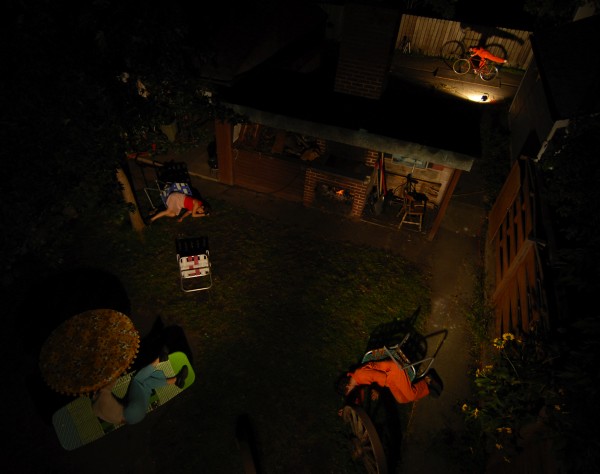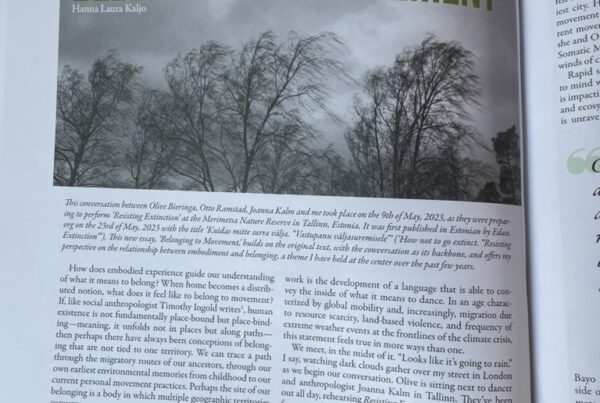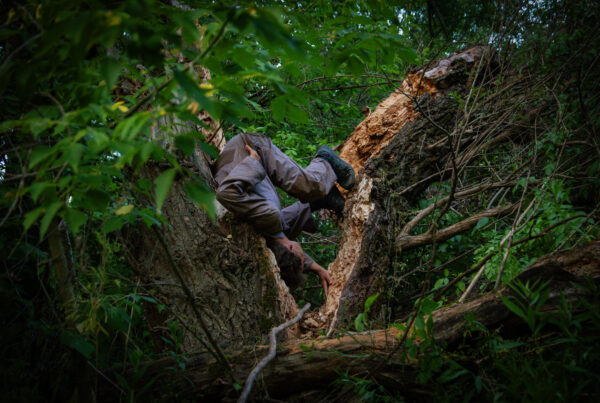Author: Camille Lefevre
Source: mnartists.org
Date: January 7, 2008
Before heading out of town during the holiday break, I arranged a phone interview with Olive Bieringa and Otto Ramstad about their three January shows at Bryant Lake Bowl. Last Sunday, January 6, Ramstad joined his fellow performers from Miguel Gutierrez’s New York troupe, Powerful People (in town for a Walker Art Center gig), in a collaborative program of new works (Downtown Comes Uptown). On Sunday, January 20, Bieringa and Ramstad (as the BodyCartography Project) present excerpts from a work-in-progress, Made in Japan.
On the middle Sunday, January 13, BodyCartography presents a series of dance films, collectively titled Moving Image: Minnesota, that Bieringa, Ramstad and friends made from 2004-2007 at places in Minneapolis and throughout Minnesota. One of these films is Seawall (2004, 20 minutes), in which performers walk on, hop down, and roll onto—sometimes in hazard-orange clothing—the Lake Superior seawall in Grand Marais. Another is Nicollet Avenue (2007, 14 minutes), in which Bieringa and Bryce Beverlin II—dressed in suits—startle onlookers by crawling in the street, rolling on patches of grass, or arduously “pulling” themselves along sidewalk cracks.
Bieringa and Ramstad call these films “site specific.” Which Bieringa, after putting me on speakerphone and tucking into her lunch, insists is not a space-time anachronism or dislocation of performance from site. “People laugh when we say we make dance films and consider them to be site-specific,” she explains while chewing. “Our films are site specific because often we’ll go into a situation and only know the location, the cast, and costuming. We don’t want to storyboard and don’t want to limit ourselves by one specific idea.”
She continues, “We come pretty open and spend time working in a place and living in a particular environment over a number of days or weeks, and build up a relationship to that place while creating material and imagery and collecting sounds. It’s all done largely from a body-mind centering perspective and other improvisational practices.”
Ramstad adds, “We consider the space or site as a medium, like we consider dance or video a medium.So when making a piece, we use the space we’re working in as a generator for the work. Mostly what we work with are the physical and visual properties of a site, not so much the historical or cultural background.”
As a scholar of site-specific dance, I’ve learned that “site-specific” is a broad term used by (most) choreographers, critics, and presenters to describe almost any dance performance not occurring on a concert stage. It encompasses work from Merce Cunningham’s “events” (the splicing together of sections from various concert dances for a one-time performance on a flat surface—a platform, a piazza—not within a concert hall) to Trisha Brown staging an iteration of her famous on rafts in Loring Park. Marylee Hardenbergh scatters performers in primary-color unitards, all of them waving brightly colored flags, throughout the Mississippi River environs; Heidi Duckler delves deeply into the cultural history of an abandoned mid-century building in Los Angeles. From Ann Carlson using the far end of the movement continuum—stillness—to resurrect the past to Joanna Haigood excavating the erased architecture, history and movements of a disenfranchised people in haunting manifestations for contemporary contemplation, these performances momentarily bring the site and its embedded memories back to life. Within this spectrum of what is commonly referred to as “site-specific” dance—with its varying degrees of orientation and response to the site itself—BodyCartography’s work lies somewhere in the middle. Take the film plant (2007, 10 minutes), for instance, which is a men’s trio shot in a World War II munitions factory in Rosemount. About this piece, Ramstad says he was drawn to “these places that, whether you know the history or not, there’s something evocative about nature pulling these structures apart, and there are lots of rooms in which to engage your imagination and develop imagery and develop physical material.”
“Because these spaces are military, they’re places you don’t know much about,” he continues. “They’re interpretation is very open. I can only take them out of context because I don’t know what they’re really made for, so it’s more creative for me to interpret what I would do there because of the unknown they hold for me and for most people.”
It is intriguing to watch these films with an eye to what choreography might have been created in situ: if and how the performers’ bodies and movements respond to physical structures and textures of the site, the ways in which the dancing body performs differently off the concert stage. But I also long for more, for a depth of orientation to the performance site that will reveal something of the silent partner that I would not, could not, have known without witnessing the performance.
Which brings me to Holiday House (2007, 14 minutes), which originated with a film shot in Bieringa and Ramstad’s home, then evolved into a concert performance in 2006 as part of the Momentum Series, and last year was performed (in another iteration) back in and around Bieringa and Ramstad’s house with the film projected on garages in the alley. As obscure as it was fun, the in-situ house version provided audiences with plenty of vantage points from which to watch performers knit on the couch, slice up vegetables, cavort like overgrown children over furniture and through the mud, ride bikes in the alley and sulk around a table.
What the piece communicated about the house, its inhabitants and their friends, however, seemingly had more to do with Bieringa and Ramstad’s conceptual ideas about performance than with the location itself. Still, I had to ask whether they consider Holiday House, because the three-part project actually centered around their house, to be their most site-specific work. “I never thought about it in that way,” Bieringa responds. “What was interesting to me was that we got to explore three different ways of sharing it with an audience.”
About the writer: Camille LeFevre is a Twin Cities dance critic and independent scholar who presents her research on site-specific dance at conferences around the country.



